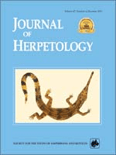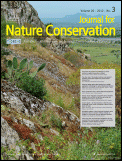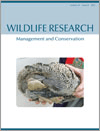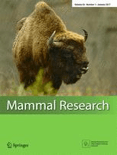
PACHYDERM
Scope & Guideline
Advancing elephant conservation through research and collaboration.
Introduction
Aims and Scopes
- Conservation Strategies and Management:
PACHYDERM emphasizes the development and assessment of conservation strategies for large mammals, especially elephants and rhinos, examining human-wildlife interactions and sustainable practices. - Ecological Research:
The journal publishes studies that explore the ecological aspects of large mammals, including habitat preferences, population dynamics, and the impact of environmental changes on these species. - Human-Wildlife Conflict Mitigation:
A significant focus is placed on innovative solutions to reduce human-wildlife conflicts, particularly in regions where large mammals and human populations coexist. - Community Involvement and Education:
PACHYDERM promotes the integration of local communities in conservation efforts, emphasizing education and awareness to foster coexistence with large mammals. - Interdisciplinary Approaches:
The journal encourages interdisciplinary research that combines ecological science, social science, and policy-making to address complex conservation challenges.
Trending and Emerging
- Translocation and Rehabilitation Efforts:
An emerging theme is the study of translocation and rehabilitation of rhinos and elephants, highlighting the importance of these efforts in conservation strategies. - Technological Innovations in Wildlife Monitoring:
There is an increasing focus on the use of technology, such as GPS tracking and monitoring systems, to enhance the understanding of large mammal movements and behaviors. - Human-Elephant Coexistence:
The concept of coexistence is gaining traction, with more research dedicated to developing tools and strategies that facilitate peaceful interactions between humans and elephants. - Cultural and Social Dimensions of Conservation:
Emerging themes include the cultural impacts of conservation efforts and the role of local communities, emphasizing the importance of social dimensions in conservation practices. - Ecological Connectivity and Landscape Conservation:
Recent studies have highlighted the significance of ecological connectivity, advocating for landscape-level conservation strategies that support large mammal migration and habitat use.
Declining or Waning
- Historical Perspectives on Wildlife Management:
While historical analyses of wildlife management practices were once prevalent, there has been a noticeable decline in papers focusing solely on historical contexts, as the journal shifts towards contemporary issues and solutions. - Niche Taxonomic Studies:
Research centered on niche taxonomic studies of less prominent species related to elephants and rhinos has decreased, likely due to a growing emphasis on more impactful conservation topics. - Ivory Trade and Trafficking Studies:
Although ivory trade has been a critical issue, the frequency of papers specifically addressing ivory trafficking has waned, potentially indicating a shift towards broader conservation strategies rather than focusing narrowly on trade.
Similar Journals

ANIMAL BIODIVERSITY AND CONSERVATION
Connecting science and passion for wildlife preservation.ANIMAL BIODIVERSITY AND CONSERVATION is a distinguished open-access journal dedicated to advancing the knowledge of animal biodiversity and conservation practices. Published by the esteemed MUSEU DE CIENCIES NATURALS-ZOOLOGIA in Spain, it provides a platform for researchers and professionals in the fields of Animal Science and Nature Conservation. With its ISSN of 1578-665X and E-ISSN 2014-928X, the journal has been committed to open access publication since 2001, ensuring that valuable research is easily accessible to a global audience. As of 2023, it holds an impressive Q2 ranking in both Animal Science and Zoology and Nature and Landscape Conservation, reflecting its impact and relevance in the scholarly community. The journal covers a broad scope of topics, contributing vital insights and fostering discussions that support the conservation of biodiversity. With key Scopus rankings revealing its standing among the top journals in its field, ANIMAL BIODIVERSITY AND CONSERVATION continues to be an essential resource for researchers, conservationists, and students dedicated to understanding and preserving the rich tapestry of life on our planet.

JOURNAL OF HERPETOLOGY
Charting New Paths in Herpetological ResearchJOURNAL OF HERPETOLOGY, published by the SOCIAL STUDY AMPHIBIANS REPTILES, is a premier platform dedicated to the advancement of knowledge in the field of herpetology, encompassing the study of amphibians and reptiles. With a dedicated ISSN of 0022-1511 and E-ISSN 1937-2418, this esteemed journal has been enriching the scientific community since its inception, with contributions spanning from 1980 to 1983 and from 1985 to 2024. As a notable entry in the Q3 category for both Animal Science and Zoology, as well as Ecology, Evolution, Behavior and Systematics in 2023, it maintains a competitive presence with a Scopus rank in the 40th and 33rd percentiles within its respective fields. Although it does not currently offer Open Access, the journal aims to foster a deeper understanding of the ecological and evolutionary dynamics of herpetofauna, making it an essential resource for researchers, professionals, and students alike. Whether you are exploring conservation strategies or evolutionary patterns, JOURNAL OF HERPETOLOGY remains a vital contributor to ongoing discussions and discoveries in the scientific exploration of reptiles and amphibians.

ORNIS FENNICA
Championing Biodiversity Through Bird ResearchORNIS FENNICA, published by BirdLife Finland, is a seminal journal dedicated to the field of ornithology and avian ecology. Established in Finland, this journal has been a vital resource for researchers, professionals, and students since its inception, evolving through converged publication periods from 1979 to 1985 and again from 1991 to the present. ORNIS FENNICA holds a Q2 category ranking in Animal Science and Zoology for 2023, indicating its significant influence and reputation within the academic community, as reflected in its Scopus ranking of 242 out of 490 in its field. The journal aims to promote the study of birds, encompassing aspects such as behavior, conservation, and biodiversity, thus serving as a crucial platform for disseminating innovative research findings. Although it is not open access, ORNIS FENNICA remains committed to advancing ornithological knowledge and supporting the scientific community's efforts to understand and protect avian species. For those invested in the nuances of bird research, this journal offers an invaluable repository of scholarly articles, reviews, and insights.

INTERNATIONAL JOURNAL OF PRIMATOLOGY
Shaping the Future of Primate StudiesINTERNATIONAL JOURNAL OF PRIMATOLOGY, published by Springer, stands as a pivotal publication in the fields of Animal Science and Zoology, as well as Ecology, Evolution, Behavior, and Systematics. With an impressive impact factor that places it in the Q1 category for both disciplines, this journal facilitates the dissemination of high-quality, peer-reviewed research that spans a diverse array of topics related to primate biology and conservation. Established in 1980 and continuing through 2024, it provides a vital platform for researchers, professionals, and students alike to explore the complexities of primate behavior, ecology, and evolution. While currently not offering open access, the journal is highly respected within the academic community, reflected in its Scopus Rankings that highlight its sustained influence and contribution to the field. The journal's commitment to advancing knowledge and understanding of primate species makes it an essential resource for anyone dedicated to this important area of study.

Frontiers in Conservation Science
Fostering Collaboration for a Greener TomorrowFrontiers in Conservation Science, published by Frontiers Media SA in Switzerland, is an esteemed open-access journal dedicated to advancing research in the field of conservation science. With an E-ISSN of 2673-611X, this journal aims to facilitate the exchange of knowledge among researchers, professionals, and students by publishing high-quality, peer-reviewed articles that explore innovative solutions to contemporary conservation challenges. Since its establishment in 2020, the journal has rapidly ascended to a Q2 ranking in the Nature and Landscape Conservation category, reflecting its commitment to impactful scholarship, as evidenced by its Scopus rank of #93 out of 211 in Environmental Science and a 56th percentile ranking. By promoting open access, Frontiers in Conservation Science ensures that vital research is widely disseminated, fostering collaboration and informed decision-making in the conservation community. This journal is a crucial platform for those dedicated to understanding and preserving our planet's biodiversity and landscapes.

JOURNAL FOR NATURE CONSERVATION
Bridging Theory and Application in Landscape ConservationJOURNAL FOR NATURE CONSERVATION, published by Elsevier GmbH, serves as a pivotal platform for the dissemination of applied and theoretical research in the fields of ecology, nature, and landscape conservation. With an ISSN of 1617-1381 and an E-ISSN of 1618-1093, this esteemed journal has earned a notable reputation, ranking in the Q2 category for both Ecology and Nature and Landscape Conservation in 2023. It is indexed in Scopus with commendable rankings, including #67/211 in Environmental Science - Nature and Landscape Conservation, highlighting its significance within the academic community. The journal’s diverse scope captures the complexities of environmental challenges and offers insights beneficial to researchers, conservationists, and policymakers dedicated to preserving biodiversity and facilitating sustainable practices. Situated in Munich, Germany, the journal has continuously contributed valuable knowledge since its inception in 1991, making it an essential resource for those committed to advancing conservation efforts on a global scale.

WILDLIFE RESEARCH
Shaping the Future of Wildlife Ecology and PolicyWILDLIFE RESEARCH is a leading journal dedicated to the rigorous study of wildlife ecology and management, published by CSIRO PUBLISHING in Australia. With a notable ISSN of 1035-3712 and an E-ISSN of 1448-5494, this prestigious journal has been at the forefront of advancing knowledge in the fields of ecology, evolution, behavior, and systems since its inception in 1974. Spanning over four decades, WILDLIFE RESEARCH has established itself as a Q1 journal in Ecology, Evolution, Behavior and Systematics and Q2 in Management, Monitoring, Policy and Law as of 2023, indicating its substantial impact and relevance in these critical areas. It ranks impressively in Scopus, with scores in the 72nd and 58th percentiles respectively for its categories, reflecting its commitment to high-quality research. The journal does not offer open access options, but it provides valuable insights for researchers, professionals, and students aiming to contribute to wildlife conservation and management practices. As it approaches its 50th year, WILDLIFE RESEARCH continues to play an essential role in shaping the discourse around environmental science, policy, and biodiversity conservation in the global landscape.

Human-Wildlife Interactions
Advancing Knowledge for a Harmonious Future with Wildlife.Human-Wildlife Interactions, published by the JACK H BERRYMAN INST, is a leading open-access journal dedicated to the critical study and understanding of the complex relationships between humans and wildlife. Launched in 2007, the journal has become a pivotal platform for researchers, practitioners, and students in the fields of ecology and conservation. It is based in the heart of ecological research at Utah State University, bringing together diverse perspectives that illuminate both the challenges and solutions associated with wildlife interactions. With an impact factor reflected in its respectable Q3 ranking in Ecology and Nature and Landscape Conservation, it demonstrates a solid contribution to these scientific domains. Researchers exploring innovative conservation strategies, wildlife management practices, and the socio-economic impacts of wildlife are encouraged to submit their studies, enhancing the journal's role in fostering dialogue and advancing knowledge in this vital area of environmental science. Accessible to a global audience, Human-Wildlife Interactions continues to promote scholarly discourse in a way that supports the sustainable coexistence of people and wildlife in our shared environments.

Mammal Research
Innovating Insights into Mammals and Their EcosystemsMammal Research, published by Springer Heidelberg, is a prominent academic journal dedicated to advancing knowledge in the fields of Animal Science, Zoology, Ecology, Evolution, and Behavior. With an impressive Q2 ranking in both Animal Science and Zoology and Ecology, Evolution, Behavior and Systematics as of 2023, this journal is an essential resource for researchers and professionals seeking to publish innovative findings that contribute to our understanding of mammalian biology. The journal operates under an Open Access model, allowing a wide audience to access and engage with high-quality research articles. Converging between 2015 to 2024, Mammal Research serves as a vital platform for scholarly discourse, promoting rigorous scientific inquiry and collaboration among experts and students alike in the fascinating study of mammals.

California Fish and Wildlife Journal
Connecting Science and Policy for a Greener FutureCalifornia Fish and Wildlife Journal, published by the California Department of Fish and Wildlife, is a pivotal platform dedicated to advancing the understanding of fish and wildlife management and conservation. As an open access journal, it fosters collaboration and knowledge sharing among researchers, practitioners, and students interested in aquatic and terrestrial ecosystems. With a focus on empirical research, policy implications, and innovative conservation strategies, the journal plays a crucial role in informing both scientific communities and decision-makers alike. Researchers seeking to contribute to critical discussions on sustainability, habitat preservation, and biodiversity will find this journal an essential resource. The journal’s commitment to disseminating knowledge about California's rich natural resources enhances its stature in the field of wildlife management and conservation studies.